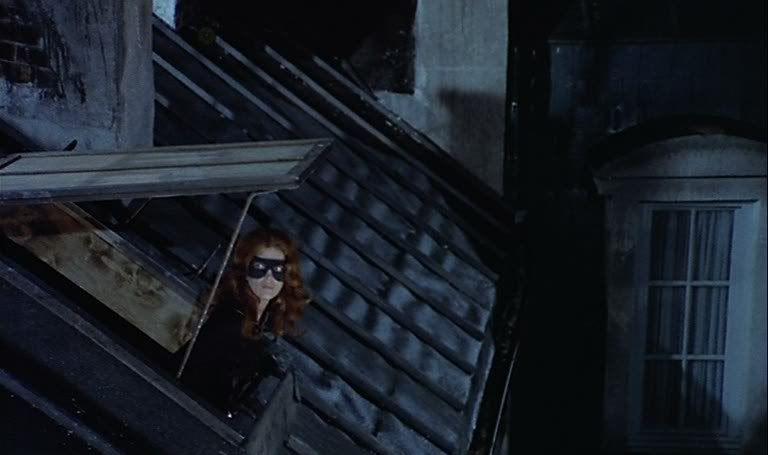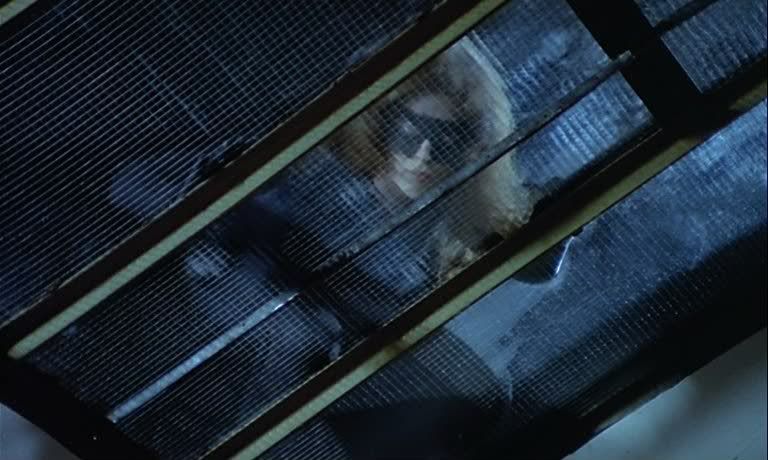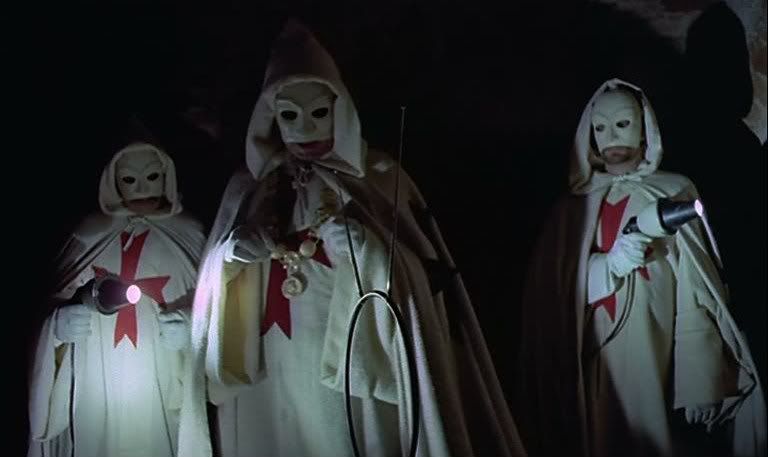
With Nuits rouges, Georges Franju returned to the territory of Louis Feuillade, whose adventure serials also provided the inspiration for Franju's 1963 Judex. Made a decade later, Nuits rouges is far wilder, more garish and absurd, than its predecessor: if Franju's Judex captured the mystery and poetic magic of Feuillade, this later tribute is all about the pulpy delights of Feuillade, the over-the-top pleasures of a ludicrous, convoluted narrative, secret conspiracies, spies and killers in stylized costumes. The narrative revolves around the mythical treasure of the Templars, a secret long guarded by this secret society and coveted by all others who suspect its existence. The nameless master criminal (Jacques Champreux) known only as "the man without a face" is one of those who seek this treasure, and is willing to do anything to get it. He is a master of disguise (even if many of his disguises, in the grand tradition of movie disguise masters, consist of nothing but a cheap wig or a false nose) and often appears in a sleek black suit and red mask, behind which his eyes are insane and unblinking.
Quite frankly, this movie is nuts. The elusive Templar treasure provides a (slim) justification for one loony set piece after another, as the red-masked villain's secret criminal organization squares off against the Templars in their white robes and masks. The film was edited down from an eight-episode television miniseries, which presumably made more sense in terms of narrative, but here Franju has distilled the story down to its bare essence, one weird moment after another with little concern for continuity. In the midst of all this scheming and spy movie pastiche, Paul (Ugo Pagliai) gets drawn into the mystery because of his murdered uncle, who had been safeguarding the Templars' treasure, while police inspector Sorbier (Gert Fröbe) tries to make some sense of this all and the "poet detective" (whatever that is) Séraphin (Patrick Préjean) keeps bumbling along and screwing everything up. Franju's visual imagination is in high gear throughout, spinning out a goofy, endlessly inventive series of colorful set pieces. Thus the red-masked criminal's lair is a cross between a sci-fi compound and a business office. The villain marches through secret passages and sits down behind a silvery desk — cheap and fake-looking, like it's simply been coated in aluminum foil — but then calls his employees over the intercom like he's paging his secretary, and asks for files. His criminal underlings sit in neat rows at typewriters, dressed in black jumpsuits to match their boss' outfit, though without the nifty red mask.


Franju is obviously toying with his genre lineage here, drawing on Feuillade's black-suited spies and adventurers, all the weird secret organizations, the rappelling along rooftops, the strange technology that's more or less represented by cardboard boxes and TV rabbit ears. Franju also respects another standard of the genre: the lousy, hammy performances and awkward dubbing that infuses the film with such a disorienting, amateurish disconnect. The multinational cast hardly delivers any convincing performances, and some of the smaller players are especially laughable: a professor (Henry Soskin) makes his big death scene absolutely hysterical by squealing melodramatically as he watches his would-be killer approach. Franju highlights the moment by zooming in, as though his camera was going to keep probing until its lens was engulfed by the professor's gaping, screaming maw. Franju is obviously delighted by the inconsistent, knowingly silly performances on display here, and he manages to make a virtue of the film's campy self-consciousness by reveling in the unrestrained quality of it all.
Certainly, the uneven performances are counterbalanced by the lo-fi visual beauty of the film. Franju's sets might be minimal and deliberately, transparently artificial, but his aesthetic sense makes them beautiful in that knowingly fake way that so often informed the early cinema (but, ironically, not so much Feuillade, whose films relied more on surface realism and location shooting). At times, Franju seems to be nodding as much to the golden age of Hollywood cinema as he is to Feuillade. A sequence where the red-masked villain's sexy accomplice (Gayle Hunnicutt) stalks across the rooftops in a cat burglar outfit and domino mask is especially evocative of Hitchcock's To Catch a Thief. It has that same stylized atmosphere, the eerie darkness, the slinky woman tiptoeing across the roofs on a mysterious mission. And when she arrives at her destination and looks down into the room where her target lies sleeping below, Franju switches to a shot from the other side of the window: the woman's face hazy and distorted through the frosted glass, her features abstracted by the distortion. Batman's nemesis Catwoman, and comics in general, are another obvious touchstone. It all ties back to Feuillade as the common source, the cinema's great pioneer of pulp storytelling, the root of so many of these iconic images.


Franju also incorporates a nod to the classic horror cinema, including his own early mad science feature Eyes Without a Face, still probably his most famous film. The mad scientist (Clément Harari) here is a truly deranged figure, a sinister and wacky monster who sweats and bulges his eyes out as he operates on his "patients." His goal? To create lobotomized robots — the ideal common man, in his view — with no brain activity, who will do anything they're ordered to do, and who can be used as zombie assassins. He keeps these zombies in simple wooden coffins with nutrient drips, and rants over them about how helpful his work will be for the future of society. These perfect slaves will aid the economy and the military, creating a workforce that can be stored away and turned off during periods of downturn, without inconvenience to the world's elites and rulers, who will alone retain their agency and minds. It's a nightmare vision, and Franju illustrates it quite literally when an army of these zombies, disguised as mannequins, attempt to kill Paul and Séraphin. It's a pointed satirical jab — at the dehumanization and oppression of the populace by elites — in a film that's otherwise concerned with being simply a fluffy tribute to old movies and old genre tropes.
That might seem a relatively modest goal, but Franju has so much obvious fun with this material that Nuits rouges is a purely joyous experience. Even more than Franju's Judex, in which he explores the poetic resonances of this material, Nuits rouges captures the trashy, pulpy qualities of old cinema, the bold visual ideas and the excitement of never knowing what wild idea is coming up next.

6 comments:
How do you come across these Franju films? Ever since I saw Eyes Without a Face, I've been keen to see other films by him...
Nuits rouges and Judex have been released as a double feature on DVD by the Masters of Cinema label in the UK. If you can play DVDs from that region (and everyone who loves cinema should make the effort to go region-free) it's a great set.
I saw this once in cut form. Quite enchanting as I recall -- especially gayle Hunnicutt. It should be noted that a shotp the hero/villain utilizes as his semi-headqusrters is called "Au Bonheur des Dames" in honor of Emile Zola -- Franju's greatest literary enthusiasm.
"Au Bonheur des Dames" is THE book about modern consumerism.
How long is the Masters of Cinema edition of Nuits Rouges ?
The Masters of Cinema DVD, which I am holding in my hand right now, runs 104 minutes (Judex goes 94).
"Made a decade later, Nuits rouges is far wilder, more garish and absurd, than its predecessor: if Franju's Judex captured the mystery and poetic magic of Feuillade, this later tribute is all about the pulpy delights of Feuillade, the over-the-top pleasures of a ludicrous, convoluted narrative, secret conspiracies, spies and killers in stylized costumes."
Ed, I think you nailed it right there early in your review, though of course that's only the summary that leads to your typically exceptional and exhaustive study of the work at hand.
Yes, this is as bizarre a work we have, but it does inform the "trashy and pulpy" qualities of old cinema.. NUIT ROUGES is far more connected to FANTOMAS (obviously) than to JUDEX (1963), which it shares the MOC DVD with. JUDEX is black-and-white, NUIT ROUGES is in color, JUDEX is set back in the early 1900's, NUIT ROUGES is modern, and there is far more of an emotional underpinning in the earlier film, for the dream-like NUIT ROUGES doesn't have the melodrama of JUDEX, nor the "continuity" as you well delineate here.
The images in the film are stunning (and God did you choose the right screen caps here!) but for me EYES WITHOUT A FACE is on balance Franju's best film.
David, yes, the MOC disc is the 104 minute theatrical cut, not the TV version.
Sam, that's a good explanation of the differences between these 2 Franju films, both tributes to Feuillade but very, very different otherwise. I'd agree with you that Eyes Without a Face is still his best work, but these films are also entertaining in their own skewed way.
I always though of Franju as a more talented and better skilled Ed Wood. Judex is available in the US from Amazon but unfortunately Nuits Rouges is not.
Excuse my ignorance Ed, but are there DVD players that are region free?
Post a Comment